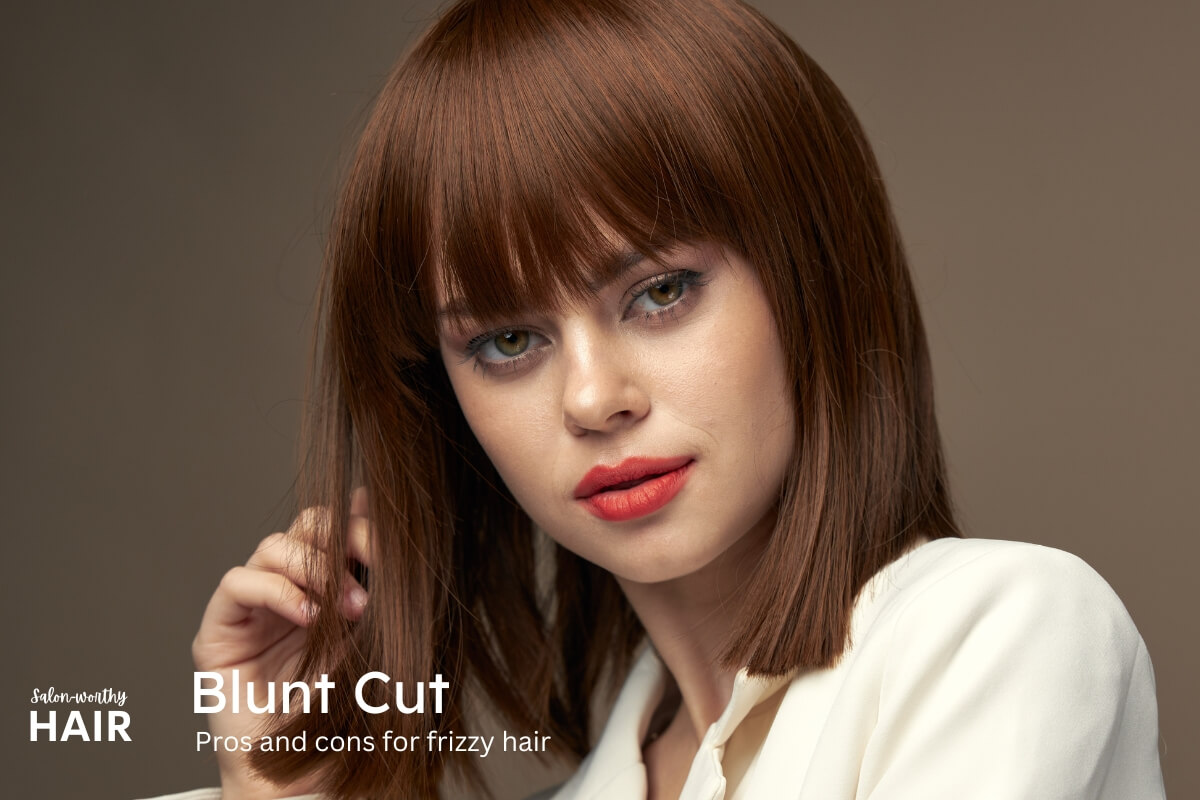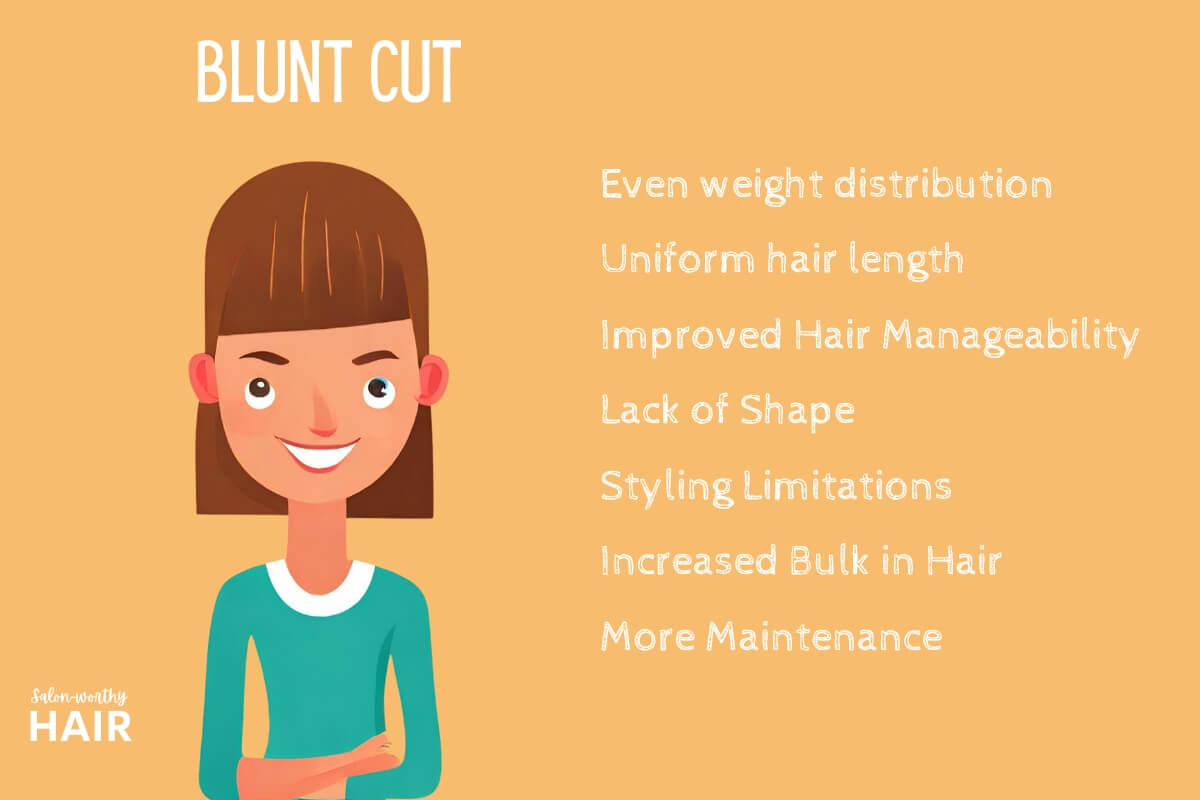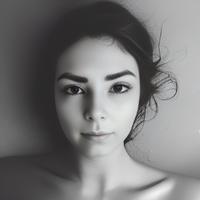Is a Blunt Cut Good for Frizzy Hair?
Updated on
This post may contain affiliate links. As an Amazon Associate, we may earn from qualifying purchases.

A blunt cut is a haircut that does not have layers or variations in length. It is a specific hairstyle that cuts the hair to a single, even length. The ends of the hair in a blunt cut are typically very straight and precise.
When considering a blunt cut, factoring in hair texture and type is essential, as the end results can vary. For example, people with very curly or frizzy hair might find that a blunt cut may not always be the best choice due to the lack of layering.
Frizzy hair does not align smoothly, often appearing dry, puffy, or chaotic due to various factors such as humidity, hair damage, or genetics.
Blunt cuts can reduce the puffiness in frizzy hair and the appearance of flyaways and unevenness at the ends. But in some cases, without layers to distribute volume, the straight line of a blunt cut might contrast more noticeably with the frizz, making any deviation from the desired style more evident.
Ultimately, those with frizzy hair considering a blunt cut should weigh the potential benefits and drawbacks based on their hair type, length, and personal style preferences.

Table of Contents
Reasons Why a Blunt Cut Can Be Good for Frizzy Hair
Here are the reasons why a blunt cunt can be good for frizzy hair:
Even Weight Distribution
A blunt cut impacts weight distribution in hair due to its even and consistent length across the head without any layering.
When hair is cut in a uniform length without layers, as in a blunt cut, the weight of the hair is evenly distributed across that length. The even distribution can influence the hair’s behavior, especially regarding movement and volume.
Frizzy hair, by its nature, tends to puff out or appear voluminous because the individual hair strands do not align smoothly. The consistent weight of the hair from a blunt cut can pull the hair down slightly, counteracting some of the puffiness or volume inherent in frizzy hair. Moreover, the even ends create a more cohesive appearance, potentially minimizing the look of stray or frizzy strands sticking out.
Because the blunt cut is precise and even, it can impart a neat and polished look, which might contrast and balance the naturally chaotic appearance of frizzy hair.
However, it is essential to note that the effectiveness of a blunt cut for managing frizzy hair can vary depending on the individual’s hair thickness, curl pattern, and other factors. For some, the lack of layers in a blunt cut could make the hair appear too bulky or voluminous.
Uniformity
A blunt cut promotes uniformity in the hair’s appearance. Cutting the hair to one uniform length ensures that it presents a cohesive and continuous line. This uniformity can make the hair look more consistent and neat, regardless of its texture.
The precise, straight edges common in a blunt cut can define the hair’s perimeter, emphasizing its uniform appearance. Layered hair, in contrast, can present more varied profiles.
For people with frizzy hair, the inherent uniformity of a blunt cut can counteract and balance the naturally chaotic appearance of frizzy hair. Instead of the hair looking unruly, the straight ends can bring a sense of order.
Frizzy hair often has flyaways, especially at the tips. The even ends of a blunt cut can help in masking or reducing the prominence of these flyaways. A blunt cut’s clear and uniform lines can offer a more polished and refined appearance.
Improved Hair Manageability
A blunt cut can improve hair manageability and reduce frizz by creating consistent weight across the hair, reducing tangles and split ends, and giving the hair a more cohesive appearance.
One of the defining features of a blunt cut is its uniform length throughout. This consistent weight can pull the hair down slightly, helping to tame and control some of the natural puffiness or volume often associated with frizzy hair.
With all the hair being the same length and no layers to contend with, styling can become more straightforward. For those with frizzy hair, this can mean fewer tangles and less time spent trying to get layers to cooperate or blend in with the rest of the hair.
The straight-across cut of a blunt style can help prevent split ends and breakage, especially if the hair is regularly trimmed. Healthier ends can contribute to reduced frizz and easier hair management.
Frizzy hair often has strands or sections that seem to have a mind of their own. A blunt cut can present a more cohesive appearance, making the hair look neater and more controlled.
The blunt ends can help weigh down the hair, which may reduce the propensity of frizzy hair to expand outwards, especially in humid conditions.
Reasons Why a Blunt Cut Might Not Be Good for Frizzy Hair
While a blunt cut offers a sleek and polished look, it might not always suit those with frizzy hair. Here are some of the drawbacks of blunt cuts for frizzy hair:
Lack of Shape
The lack of shape in a blunt cut does not provide the nuanced structure that can help counterbalance or camouflage the inherent characteristics of frizzy hair. Instead, it can sometimes emphasize aspects one might wish to downplay.
Blunt cuts give hair a consistent length without the layers that can help distribute and break up the volume. For frizzy hair, this uniformity can mean that all the volume and puffiness get emphasized equally, making it look more voluminous and frizzy than if there were layers to create shape and depth.
Layers create gradation in length and allow strands to fall over each other to camouflage or diffuse the look of frizziness. With a blunt cut, there is no such gradation, so any frizziness is fully displayed.
One of the benefits of layers is that they can introduce movement and dynamism to hair, making it appear lively and fluid. A lack of shape in a blunt cut can make frizzy hair look static and, when paired with the unruliness of frizz, can result in a more chaotic and less defined look.
In frizzy hair, the ends might not always lie smoothly due to varying degrees of curl, wave, or damage. In layered cuts, these varying lengths can blend into one another. However, in a blunt cut, the ends are all the same length, so any frizziness or irregularities at the ends can be more noticeable, making the hair appear even frizzier.
Styling Limitations
A blunt cut has a consistent length, which creates less room for such adjustments. In contracts, with layered cuts, one has the flexibility to style layers differently to play with textures. This variability can help in masking or dispersing frizz.
When all the hair is of a uniform length, it might require more product to achieve a smooth and consistent texture, especially for those with frizzy hair. Overusing products can sometimes exacerbate frizz or make hair appear greasy.
When pulling blunt-cut hair into an updo or bun, the consistent length might lead to bulkier sections or stray ends sticking out, emphasizing frizziness. In contrast, layered cuts often tuck more seamlessly into updos due to the variation in hair lengths.
With more complex hairstyles, the style can distract attention from hair texture, including frizz. However, the simplicity of a blunt cut might direct more focus onto the hair’s surface and any existing frizz.
To counteract frizz in a blunt cut, individuals might be inclined to use heat styling tools more frequently to achieve a sleeker look. Regularly using such tools without proper protection can lead to hair damage and, paradoxically, more frizz.
Increased Bulk in Hair
The increased bulk from a blunt cut can make frizzy hair look even frizzier by emphasizing its natural volume and puffiness.
Since a blunt cut offers a uniform length, the hair has an even weight distribution. For frizzy hair, this consistent length can make all the frizz and volume more pronounced, making the hair look puffier and more voluminous.
Layers in a haircut can help distribute and diffuse the hair’s volume, especially for thick or curly hair types. The hair’s natural volume and any associated frizz are emphasized without these layers, as in a blunt cut.
In a blunt cut, the ends of the hair are all cut straight across, which can lead to a thicker appearance at the bottom. For someone with frizzy hair, this can make the frizziness at the ends more noticeable, especially if the hair starts to puff out.
For those with curly and frizzy hair, a blunt cut, especially if grown long without layers, can sometimes result in a “pyramid” effect, where the hair is flat at the top and wide at the bottom. This shape can accentuate the frizz and make it appear more pronounced.
The precise and even nature of a blunt cut might contrast sharply with the irregular texture of frizzy hair. This juxtaposition can make the bulkiness and any associated frizz stand out even more.
Increased Maintenance
A blunt cut, despite its seemingly simple appearance, can require more maintenance to keep it looking sharp and precise. Maintaining that precision can require significant effort. This increased maintenance, especially if not done correctly or consistently, can inadvertently highlight or increase frizziness.
The defining characteristic of a blunt cut is its crisp, even edge. To maintain this sharpness, regular trims are necessary. If not maintained, the ends can begin to appear ragged or split, which can accentuate frizz.
Those with a blunt cut (especially naturally frizzy or wavy hair) might frequently use heat-styling tools to maintain a sleek appearance. Over time, this can lead to hair damage, dryness, and, subsequently, more frizz.
Keeping a blunt cut looking pristine might require various hair products, from smoothing serums to hairsprays. Overusing or not adequately washing out these products can lead to product buildup, making hair less manageable and potentially emphasizing frizz.
Everyone’s hair grows at slightly different rates in various parts of the head. Over time, what was once a perfectly straight blunt cut might become uneven due to these natural growth variations. If not regularly addressed, this unevenness can contribute to a messier appearance, making frizz more noticeable.
For those with naturally curly or wavy hair, maintaining the straight appearance of a blunt cut can be labor-intensive. If one decides to let their natural texture shine through occasionally, the contrast between the blunt ends and the natural frizz or curl can make the hair look more frizzy than with a layered cut.
Finally, given that a blunt cut requires consistent texture and appearance for the best look, it might be more vulnerable to humidity, wind, and other environmental factors that induce frizz.
Alternative Haircuts for Frizzy Hair
While a blunt cut can offer a sleek look and minimize frizz to some extent, it may not always be the best choice due to maintenance challenges and styling limitations. For individuals seeking alternatives that complement and manage frizz, exploring other haircuts tailored to embrace and control natural textures can lead to more flattering and manageable results.
For more inspiration, check out:
The best haircuts for frizzy hair.
A Blunt Cut for Frizzy Hair May Not Always Be the Best Choice
A blunt cut offers a stylish and polished appearance that many find appealing. Its uniformity can reduce the appearance of split ends and potentially simplify daily hair care routines. For some, especially those with thin or straight hair, it can add a semblance of volume and structure.
However, the features that make a blunt cut attractive can pose challenges, especially for those with frizzy or textured hair. The cut’s consistent length can emphasize bulkiness or puffiness and might not always mesh seamlessly with natural hair patterns.
Moreover, maintaining its crisp appearance can require increased styling efforts, potentially leading to further hair damage or an amplified frizzy look. While a blunt cut holds undeniable charm, its suitability depends on individual hair type, texture, and personal styling preferences.
About the Author
 Tina Moretti
Tina MorettiTina Moretti, a passionate hair care enthusiast with over a decade of expertise, dedicates herself to empowering women with proven hair care advice. Recognized for her hands-on experience and trusted guidance, Tina turns every strand into a statement of beauty and confidence.